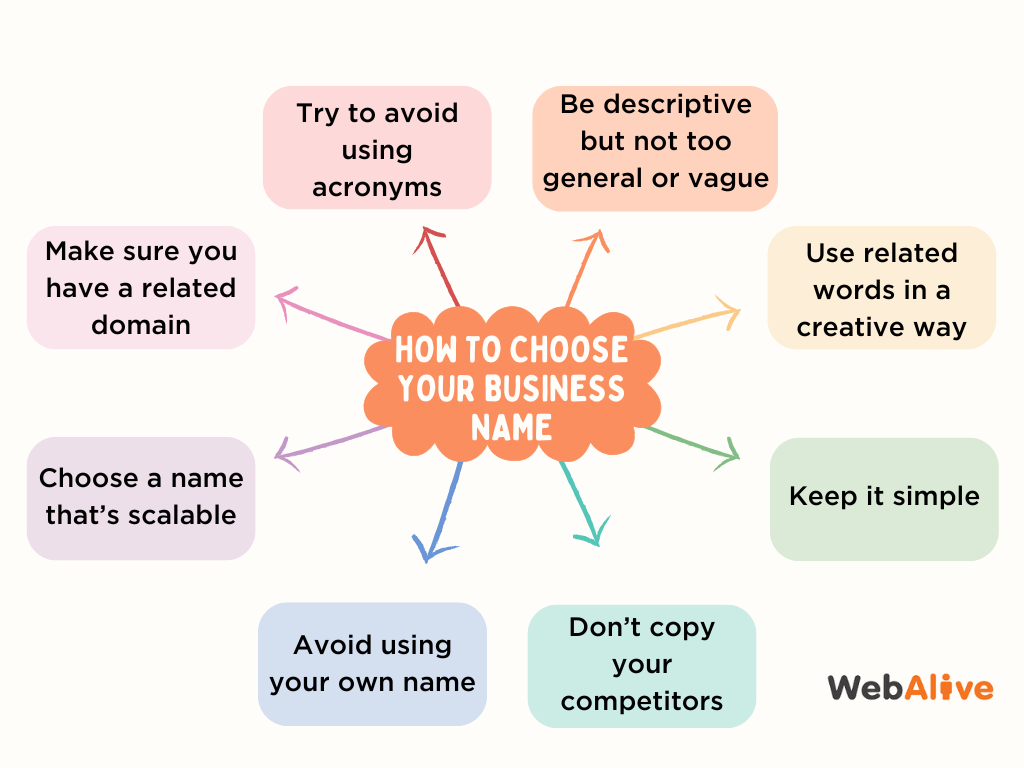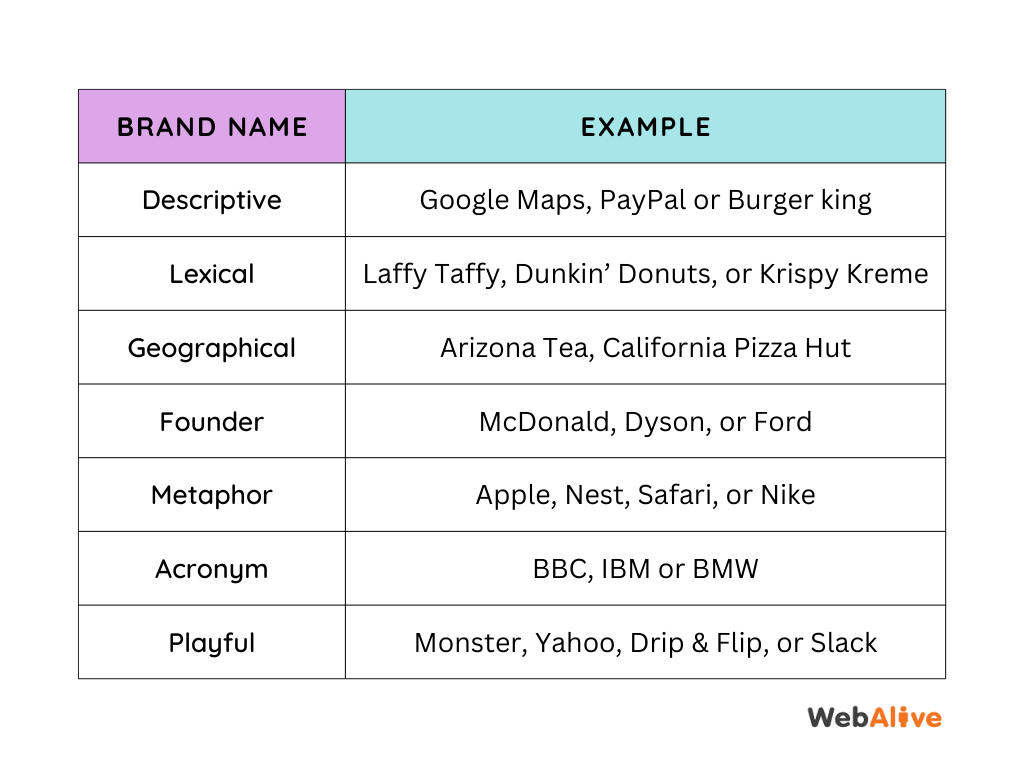
How to Choose a Perfect Business Name | 8 Things to Consider
You can’t have a business without a business name!
But the process of choosing the perfect business name that is both catchy and communicates what your business is about is by no means easy. Businesses have failed in the past largely due to a name that just didn’t work, so it’s important to get this right.
Choosing a good business name is very important if it’s going to be successful, and it’s key to differentiating you from your competitors. Customers associate a business name with the value it provides to them.
Why is your business name important to success?
When we mention the brand name KFC, what is the first thing that comes to your mind? Is it the iconic red and white logo with Colonel Sanders or the slogan “Finger-Lickin’ Good”? Or the mouth-watering aroma of fried chicken?
This happens because, through its name alone, KFC has crafted a brand identity.
And this single example shows the power of a business name. It acts as a cornerstone of your brand as well as helps you stand out from the crowd. Otherwise, there is no point if you and your competitors all look the same and offer the same service. It is the name of your business that differentiates you. With strong brand names comes customer loyalty. Hence, it is wiser to do enough brainstorming to come up with a catchy, easy-to-remember brand name.
Legal considerations to consider to register your brand name in Australia
Before starting your quest for picking up the perfect business name, you should have a clear idea of what type of business structure you are going to have. This is important because rules regarding name registration vary depending on the structure of your business.
- If your business is a company, you need to register the business name at the time of registering your company.
- If you are a sole trader or have a partnership, you need to register your business name with the ASIC, unless your business is named after you or your partner.
Here are the steps you need to take to register your business name using ASIC Connect.
- Log in to ASIC Connect and select the Licences and Registrations tab at the top of the page
- You need to select the Business name from the drop-down box
- Enter your ABN number. You must have an ABN number to register a business name
- Place your proposed business name
- Select the registration period
- Enter the business name holder details as well as the address
- Make your payment and confirm the transaction
One obvious thing to do while naming your business is to check if the name is already in use.
Technically speaking, unless a business name in Australia is registered as a trademark, it can be used by multiple entities. However, considering the brand value your business name carries, it should be unique and easily distinguishable from others.
How do you find out if a business name is already taken?
In Australia, you can check for the availability of business names from the ASIC website. Registration and subsequent renewal take only A$37 per year or A$88 for three years. You can update or transfer your business name for free. If you are thinking about registering your business name as a trademark too, check IP Australia to find out the already registered trademarks.
And if you are planning to create a website or email address for your business, you need to register using an available domain name as well. In order to register a domain name you can do it through a registrar or reseller listed on the .au Domain Administration Ltd (.auDA) website or your website hosting company may also register domain names.
How to choose a name for your business
As discussed, the main purpose of a name should be to communicate what services you offer while being easy to remember and unique, if possible. Here are a few useful tips to keep in mind:

1. Be descriptive but not too general or vague
Don’t choose a name that is too vague or too meaningful. Generic names, like – Melbourne Painting Service, is not only boring but also not easy to remember. Moreover, it doesn’t stand out from other providers. Now consider the name PhotoBucket – descriptive enough, not boring, and not something you’re likely to forget.
2. Use related words in a creative way
Don’t be tempted to stuff keywords into your business name. Using plain keywords like General Motors doesn’t work anymore. But often, choosing a somewhat modified version of related keywords works very well, provided it expresses what your business is about.
A good way to create catchy, memorable business names is to use alternate versions of common words related to the service you’re offering. For example, the name Attensa is quite perfect for the content aggregation tool.
The name is a play on the word attention – which is somewhat relatable to the service itself. Other examples include Digg (dig), Flickr (flicker) and Compaq (compact).
3. Keep it simple
Don’t choose a name that is too long or complicated. Remember that your business name needs to be appealing to your customers. It should sound pleasant, familiar and conjure up positive emotions. It also needs to be easy to pronounce and remember.
Consider the name Zippil – it’s not only hard to pronounce, but it’s downright obscure. Whenever you need to explain your business name, it’s probably not a good sign. It’s okay to be a bit clever, but don’t overdo yourself.
4. Don’t copy your competitors
Avoid choosing a name too similar to other businesses in your industry. It can mean appearing to be unoriginal, which is not good for your brand image. It can also mean potential customers confuse your business with your competition making it more difficult to get repeat work.
5. Avoid using your own name
Unless you are an established brand, avoid using your own name. Your name doesn’t communicate anything about your business and won’t mean much to potential customers. This may even cause problems if you ever want to sell your business in future or even if you wish to expand.
However, there are some rare examples where integrating the owner’s name within the brand name can work well. Examples are – Automattic (named after its founder Matt) and PageRank (named after Google co-founder Larry Page). That said, PageRank is not a business name per se; it’s an algorithm.
6. Choose a name that’s scalable
Pick a name that can expand your business. For example, if you sell just books, you might one day sell stationery products or accessories too. Also, if your service is based in a certain area, you might extend to other cities. So, select a broad name that can encompass your future growth.
7. Make sure you have a related domain
Once you’ve narrowed down your name options, you have to make sure the name you want to use is available. Check if the name is already registered as a trademark or acquired by another business. If you’re planning on having an online presence, which you definitely should, you’ll want to make sure the desired domain is available by doing a domain name check.
A domain name can impact your online visibility and influences your online marketing efforts as well. That said, you shouldn’t necessarily abandon a good business name just because an exact domain is not available. Here are a couple of things that you can do instead-
- If it’s a parked domain, consider buying it. It’s probably going to cost you, but a search-friendly, memorable domain is worth it.
- Add modifiers to the name. Say your company name is Sleepytime and you sell pyjamas, but sleeptime.com is already taken. Then you can look for domain names like sleeptimeonline.com or sleeptimepyjamas.com.
- Be creative with domain selection. Nowadays, businesses use different top-level domains to make their URLs more memorable. For example, the blogging platform Postachio chose postach.io as their domain. They chose a ccTLD (.io) which is naturally a part of their business name. Another well-known example is del.icio.us
8. Try to avoid using acronyms
Many big companies use acronyms of their name, like IBM and KFC. But at the start of your business, when your goal is to establish your brand, acronyms will only confuse your potential customers. Also, there’s a great possibility that your business acronym will match with someone else, making it very difficult for you to rank in search engines.
Should you use a business name generator?
If you are in the initial stage of brainstorming and thinking of how to pick a business name, using a business name generator can definitely be helpful.
And here’s why.
Idea Generation: Using a business name generator can help you by providing a variety of name options that you might not have considered.
Availability Check: Many generators provide you the option to check the availability of domain names and social media handles, which ends up saving your time.
Speed: It speeds up the naming process by quickly generating various options.
Inspiration: Even if you don’t use the suggested names, they can inspire you to come up with a perfect name on your own.
Keyword Integration: Generators often use keywords related to your business, which can help with branding and SEO.
Consider the 7 types of brand names

Descriptive brand name: It clearly conveys what the company or product does. Example: Google Maps, PayPal or Burger king.
Lexical brand name: You can use wordplay, including puns, alternations or coined terms to existing words, as they are easy to remember and add more fun. Examples: Laffy Taffy, Dunkin’ Donuts, or Krispy Kreme.
Geographical name: Simply, you can include the location of your business or the origin of your products in your brand name to evoke a sense of place, particularly for your local business. Examples: American Airlines, Arizona Tea, or California Pizza Hut.
Founder name: Use the name of the company’s founder or key individuals to add a personal touch and a sense of legacy. Examples: McDonald, Dyson, or Ford.
Metaphor name: Use imagery or symbolic language to convey the essence of the brand. Example, Apple, Nest, Safari, or Nike.
Acronym name: If the name is too big or complex, just use the initials of the name or phrase. Example: BBC (British Broadcasting Corporation), IBM (International Business Machines), or BMW (Bayerische Motoren Werke)
Playful brand name: Playful brand names use humour, whimsy, and fun to create a memorable brand identity. Example: Monster, Yahoo, Drip & Flip, or Slack.
Final advice
Choosing a name can be challenging when you’re setting out to start a business, but not something to agonise over! Remember to get opinions and ideas from friends, family or even potential customers. It’s always a good idea to get a few different points of view.
A business name is only your first step towards building a brand. Though it’ll give your business a good first impression, it’s up to you to meet the customer expectations and bring your business to success.
You read a lot. We like that
Want to take your online business to the next level? Get the tips and insights that matter.

